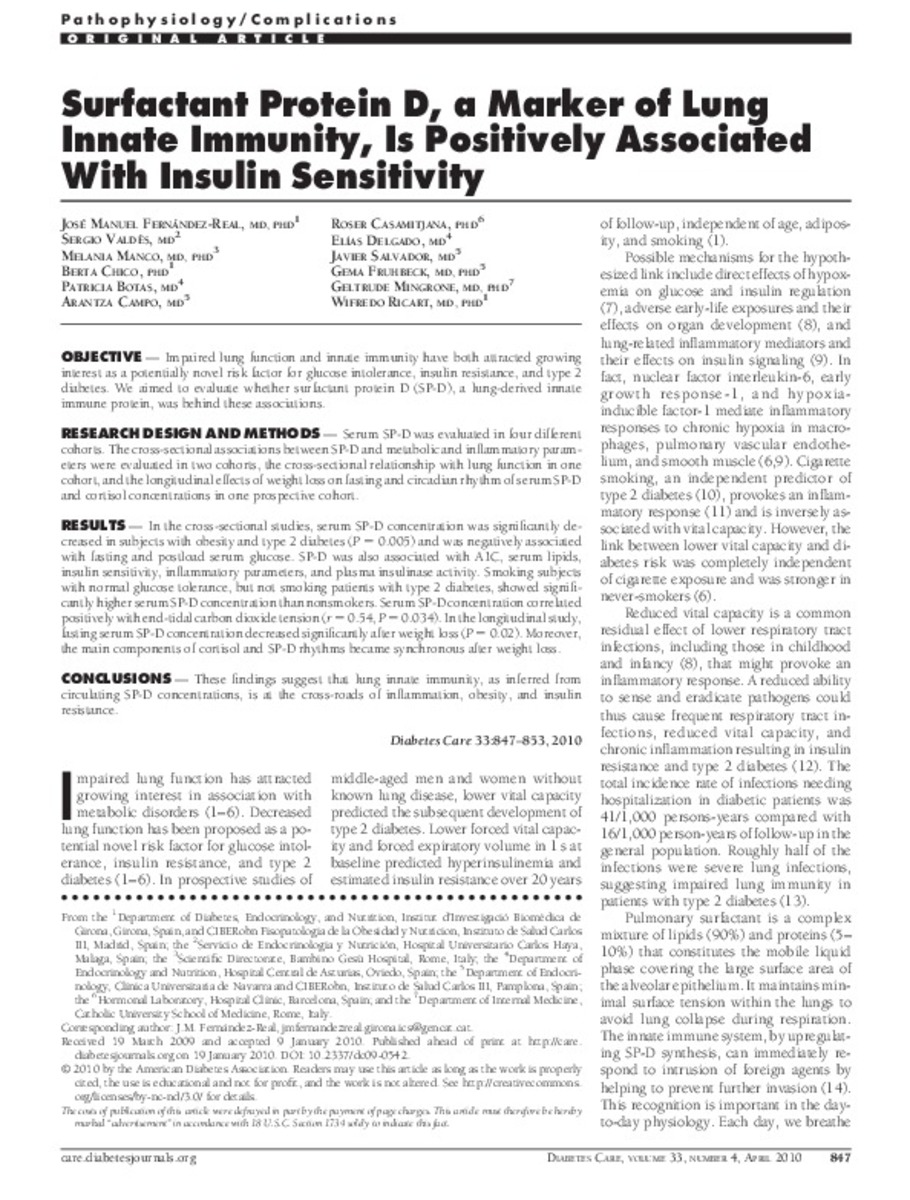Full metadata record
| DC Field | Value | Language |
|---|---|---|
| dc.creator | Fernandez-Real, J.M. (José Manuel) | - |
| dc.creator | Valdes, S. (Sergio) | - |
| dc.creator | Manco, M. (Melania) | - |
| dc.creator | Chico, B. (Berta) | - |
| dc.creator | Botas, P. (Patricia) | - |
| dc.creator | Campo, A. (Arantza) | - |
| dc.creator | Casamitjana, R. (Roser) | - |
| dc.creator | Delgado, E. (Elías) | - |
| dc.creator | Salvador, J. (Javier) | - |
| dc.creator | Frühbeck, G. (Gema) | - |
| dc.creator | Mingrone, G. (Geltrude) | - |
| dc.creator | Ricart, W. (Wifredo) | - |
| dc.date.accessioned | 2014-07-15T10:18:38Z | - |
| dc.date.available | 2014-07-15T10:18:38Z | - |
| dc.date.issued | 2010 | - |
| dc.identifier.citation | Fernandez-Real JM, Valdes S, Manco M, Chico B, Botas P, Campo A, et al. Surfactant protein D, a marker of lung innate immunity, is positively associated with insulin sensitivity. Diabetes Care. 2010 Apr;33(4):847-53. | es_ES |
| dc.identifier.issn | 0149-5992 | - |
| dc.identifier.uri | https://hdl.handle.net/10171/36161 | - |
| dc.description.abstract | OBJECTIVE:Impaired lung function and innate immunity have both attracted growing interest as a potentially novel risk factor for glucose intolerance, insulin resistance, and type 2 diabetes. We aimed to evaluate whether surfactant protein D (SP-D), a lung-derived innate immune protein, was behind these associations. RESEARCH DESIGN AND METHODS: Serum SP-D was evaluated in four different cohorts. The cross-sectional associations between SP-D and metabolic and inflammatory parameters were evaluated in two cohorts, the cross-sectional relationship with lung function in one cohort, and the longitudinal effects of weight loss on fasting and circadian rhythm of serum SP-D and cortisol concentrations in one prospective cohort. RESULTS: In the cross-sectional studies, serum SP-D concentration was significantly decreased in subjects with obesity and type 2 diabetes (P = 0.005) and was negatively associated with fasting and postload serum glucose. SP-D was also associated with A1C, serum lipids, insulin sensitivity, inflammatory parameters, and plasma insulinase activity. Smoking subjects with normal glucose tolerance, but not smoking patients with type 2 diabetes, showed significantly higher serum SP-D concentration than nonsmokers. Serum SP-D concentration correlated positively with end-tidal carbon dioxide tension (r = 0.54, P = 0.034). In the longitudinal study, fasting serum SP-D concentration decreased significantly after weight loss (P = 0.02). Moreover, the main components of cortisol and SP-D rhythms became synchronous after weight loss. CONCLUSIONS: These findings suggest that lung innate immunity, as inferred from circulating SP-D concentrations, is at the cross-roads of inflammation, obesity, and insulin resistance. | es_ES |
| dc.language.iso | eng | en_EN |
| dc.language.iso | eng | es_ES |
| dc.publisher | American Diabetes Association | es_ES |
| dc.rights | info:eu-repo/semantics/openAccess | es_ES |
| dc.subject | Biological Markers/blood | es_ES |
| dc.subject | Diabetes Mellitus, Type 2/blood | es_ES |
| dc.subject | Insulin | es_ES |
| dc.subject | Blood Glucose/analysis | es_ES |
| dc.title | Surfactant protein D, a marker of lung innate immunity, is positively associated with insulin sensitivity | es_ES |
| dc.type | info:eu-repo/semantics/article | es_ES |
| dc.identifier.doi | http://dx.doi.org/10.2337/dc09-0542 | es_ES |
Files in This Item:
Statistics and impact
Items in Dadun are protected by copyright, with all rights reserved, unless otherwise indicated.






